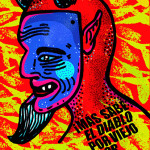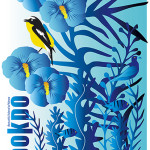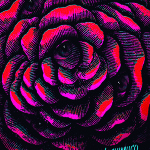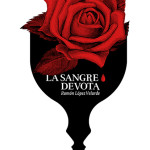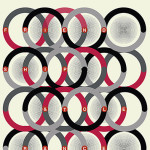Our new poster master is a passionate Mexican designer that loves to create social and cultural designs with a unique and powerful style.
Eréndida Mancilla graduated as graphic designer from the Faculty of Habitat, and has a Master degree in Graphic Design from the Research Institute, with a Postgraduate Degree from the Faculty of Habitat and a Phd in Architecture, Design and Urban planning in the DADU program of the UAEM.
She has published several articles in magazines and has been part of collective books with themes related to design. Likewise she has been a speaker at different events around Mexico and Latin America related to design and typography.
Her poster design has been featured in different exhibitions such as: Neruda 100, Sartre 100, Othón 100, Tribute to Frida Kahlo, The Demons of Eden, Women Designing (organization), No al maltrato a la mujer (Selected posters by Amnesty International), among others. She has been a member of the Aliados Collective, since 2002, and a Bluetypo design studio member since 2000.
We asked Eréndida our “Poster Poster Questions” and this is what she said about it:
1. What does the poster mean to you and why do you design posters?
For me the poster is everything … “The poster works in the very field of poetry, generates images tied to the wings of the imagination …” Making posters gives me the ability to feel and understand the world in another way. Design is an activity in which there is the possibility of creating, you can generate images that represent ideas and transmit messages, the poster is an ideal means to do so. A designer can express their opinions on any subject by using the poster.
2. What would you say makes a good poster?
To make a poster requires a hard intellectual work. A good poster is one that tells you everything with few elements, capable of transmitting a message almost instantaneously. A good poster catches you immediately, seduces you, makes you flip, envelops you, either with the forcefulness of the image or with the beauty of its aesthetics. The poster should move you to action.
3. What do you think is the role of the poster on the world today?
At present the poster continues to be valid in some countries, in others it is used less and less in its traditional printed format. Now with the arrival of digital media and social networks, the poster has been adapting and transforming. But in essence it continues to serve for the same purposes, call for reflection, generate awareness and move action, only it does so in different formats and supports.
4. What is your typical design process for making a poster?
To design a poster, the first thing I do is to think about what I want to say, the idea I want to convey; I look for references inside and outside the design, sketch different alternatives, I try them in different techniques, when I find one that satisfies me, I advance to the composition, I see the form, the size, the placement, the typography management, etc., I move constantly between the conceptual and the expressive, my work is rational and emotional at the same time. When I arrive at a result and it does not convince me, I start again. Design requires creativity but also work.
5. If you could chose a poster in history as your favorite, which one would it be and why?
The poster designed by Milton Glaser in 1967 for Bob Dylan’s Greatest Hits, commissioned by the CBS label as a special poster that was included in the album packaging. For this Glaser took inspiration in a self-portrait by Marcel Duchamp. The characteristic profile of Dylan appears with his hair in freedom and full of colors. The design evokes the psychedelic era. It is a simple poster that if you see it stuck on the wall, it makes you flip although you do not want it because of the strength that the image possesses and the organic nature of the form and color. I love it.
6. What advice would you give to new designers who might want to become poster designers?
To become a poster designer, the important thing is to know to think, to be clear about what you are going to say and to be able to represent it. This is acquired on the basis of work, trial and error, a constant cycle. Sometimes you do well, sometimes not so much, the important thing is not to give up, keep trying again and again. Inspiration does not come alone, you always have to look for triggers to generate it. I look for them in nature, in art, in philosophy, in poetry, in literature, in music, in cinema, in architecture, in geometry, etc., in short, everything that surrounds me It influences me and helps me conceptualize.
- Eréndida Mancilla
- Eréndida Mancilla
- Eréndida Mancilla
- Eréndida Mancilla
- Eréndida Mancilla
- Eréndida Mancilla
- Eréndida Mancilla
- Eréndida Mancilla
- Eréndida Mancilla
- Eréndida Mancilla
- Eréndida Mancilla
- Eréndida Mancilla
- Eréndida Mancilla
- Eréndida Mancilla
- Eréndida Mancilla











